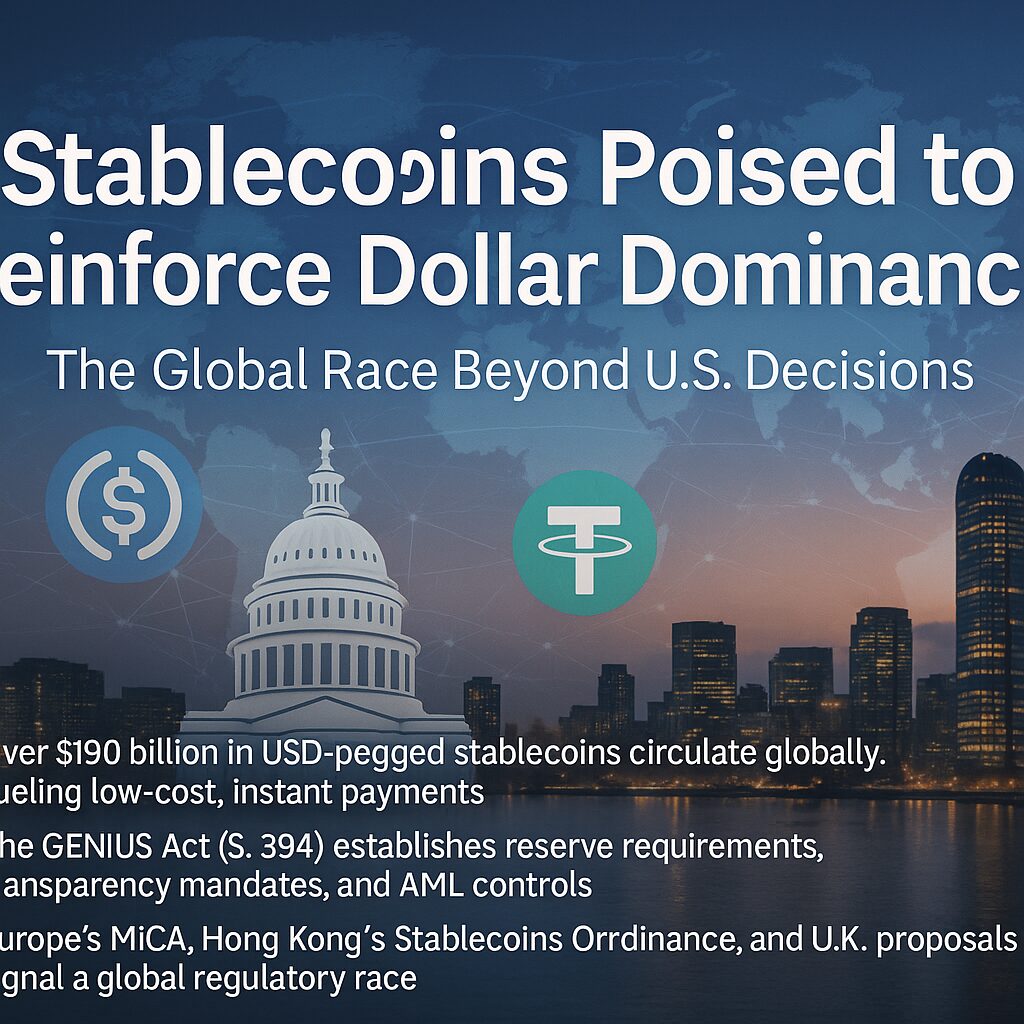
Main Points:
The Guiding and Establishing National Innovation for U.S. Stablecoins (GENIUS) Act (S. 394) is the Senate’s flagship stablecoin bill. Key provisions include:
- Reserve Requirements: One-to-one backing in high-quality liquid assets (U.S. dollars, short-term Treasury bills).
- Transparency & Audits: Mandatory independent, periodic attestations and public disclosures of reserve composition.
- AML & Sanctions Compliance: Full adherence to the Bank Secrecy Act, including robust KYC/AML and sanctions controls.
- Interest Prohibition: Stablecoins cannot bear interest, preserving their payment utility and preventing bank-like deposit displacement.
- Legal Clarity: Explicit exclusion of payment stablecoins from securities classification and bans on misleading claims about U.S. government backing or FDIC insurance.
These measures aim to “provide certainty” for responsible issuers, protect consumers, and prevent systemic risks without stifling technological progress. The bill sets a one-year implementation deadline, accelerating market entry for compliant issuers.
Bipartisan Momentum and Legislative Progress
Stablecoin regulation in the U.S. has garnered unusual cross-aisle cooperation. On June 11, 2025, the Senate overcame a filibuster with a 66-32 vote to advance the GENIUS Act, marking the first significant federal framework for payment stablecoins. Support spans from free-market advocates emphasizing innovation to consumer-protection champions prioritizing financial inclusion. Both Republicans and Democrats agree that preserving the dollar’s global role is a non-partisan “patriotic duty.”
Parallel efforts in the House with the STABLE Act further demonstrate lawmakers’ resolve. While the STABLE Act allows indefinite state oversight, the GENIUS Act’s tiered approach shifts issuers above $10 billion to federal jurisdiction—balancing local flexibility with national consistency. If both chambers concur before the August recess, federally authorized issuers could emerge by 2026.
Industry Milestones: Circle’s IPO and Market Confidence
Amid regulatory advances, Circle Internet Group’s June 5 IPO on the NYSE (ticker: CRCL) signified Wall Street’s endorsement of stablecoins. Priced at $31, shares closed the first day at $83.23—nearly a 170 percent surge—raising $624 million at a $6.9 billion valuation. As the issuer of USDC, the second-largest stablecoin, Circle’s public listing cements the token’s integration into mainstream finance.
Circle’s revenue model—99 percent of its $1.68 billion 2024 income derived from interest on USDC reserves—ties profitability directly to regulatory certainty and interest-rate environments. The IPO’s success underscores institutional appetite for transparent, compliant digital-asset platforms and places pressure on competitors like Tether (USDT) to enhance their audit and licensing regimes.
Global Competitive Landscape: EU, Hong Kong, and Beyond
While U.S. lawmakers debate stablecoin guardrails, other jurisdictions have moved swiftly:
- Europe (MiCA): The Markets in Crypto-Assets Regulation, in force since June 2023, sets detailed rules for asset-referenced tokens, governance, and consumer protection, with full application expected by late 2025.
- Hong Kong: The Stablecoins Ordinance, passed May 21 and effective August 1, 2025, requires licensure, AML/CFT compliance, and prudential safeguards for issuers of HKD-pegged tokens.
- United Kingdom: Regulatory proposals under discussion would bring stablecoins within the UK Payments Services regime, emphasizing reserve integrity and oversight.
This global chorus underscores a competitive race: jurisdictions offering clear, innovation-friendly frameworks will attract stablecoin issuers, DeFi projects, and digital-asset infrastructure. U.S. inaction could cede leadership to EU or Asia-Pacific hubs.
Addressing Illicit Use: Ensuring Trust and Compliance
Stablecoins’ programmable nature and borderless reach also attract illicit actors. In a recent U.S. prosecution, Russian national Iurii Gugnin was charged with facilitating over $530 million in sanctions-evading transactions via stablecoins, highlighting systemic vulnerabilities. Critics—including Sen. Elizabeth Warren—warn that without rigorous AML and real-time compliance, stablecoins could become conduits for money laundering, terrorist financing, and evasions of capital controls.
The GENIUS Act’s AML mandates and ties to the Bank Secrecy Act are thus critical. Requiring issuers to integrate blockchain analytics, transaction monitoring, and sanctions screening embeds “programmable compliance” into the payment rails—enhancing transparency and law-enforcement collaboration.
Practical Implications for Blockchain Adoption
For blockchain practitioners and enterprises, regulated stablecoins unlock a suite of real-world applications:
- Cross-border settlements: Lowering FX costs and settlement times for remittances and trade finance.
- Programmable money: Enabling smart-contract payments in supply-chain logistics, insurance, and decentralized identity.
- DeFi integration: Providing reliable collateral for lending, staking, and liquidity pools, facilitating yield generation in tokenized markets.
- Treasury operations: Allowing corporates to manage cash-on-chain, automate payroll, and hedge currency risks with minimal counterparty risk.
Clear rules reduce integration risk, encourage bank partnerships, and foster enterprise-grade wallets and custody solutions. As stablecoins gain regulatory legitimacy, they become building blocks for next-generation financial architectures.
Conclusion: Securing the Future of the Digital Dollar
The GENIUS Act represents a pivotal step in codifying stablecoin governance—balancing innovation, consumer protection, and national security. Coupled with global frameworks like MiCA and Hong Kong’s Ordinance, the U.S. stands at a crossroads: embrace regulatory clarity to cement dollar supremacy or risk ceding ground to nimble international competitors. As Circle’s IPO and bipartisan momentum show, market forces and political will are aligning. For blockchain innovators and investors, the time to build on these programmable rails is now—before the world’s digital payments architecture is shaped elsewhere.

